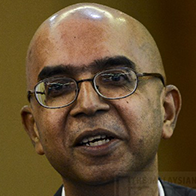Why does the government downplay the median household income? Why doesn’t the government reveal details such as how much of “household income” is notional rent for owner-occupied housing?
It’s been reported that the Statistics Department will soon issue the 2014 Household Income and Basic Amenities Survey Report and that it will claim household income has grown 18% from RM 5,000 in 2012 to RM 5,900 in 2014.
To understand what might explain this “growth,” I decided to review the 2012 report.
I noticed the median household income is not mentioned in the summary which prefaces the report, though medians are reported on many of its 133 pages.
The report celebrates averages. This is odd, because as anyone who has used statistics for decision-making knows, medians are often more important than averages. I’ll explain with an example.
Suppose the amount of ringgit in the pockets of 10 people is counted and listed as follows: 5, 6, 8, 11, 15, 20, 26, 33, 41 and 100.
The median, RM17.50, tells us half the people had less than RM 17.50 in their pockets. The average, RM36.50, insinuates that half the people had less than 36.50 in their pockets: the average massively misleads us.
So, though the report summary highlights the average household income of RM5,000, what is more important is that the median household income was RM3,626. Even that requires explanation, for it doesn’t mean what most people think it means.
For example, it would be wrong to say 50% of households in Malaysia earned more than RM 3,626 per month in 2012, because earnings are different from income. What the Report calls income is made up of five streams:
- Income from employment (salary; or proceeds from selling kuih, etc. Employers’ contributions to EPF and Socso are included; allowances and subsidies provided by employers are included);
- Value of self-consumed product, e.g. home-grown vegetables (perhaps also value of well water, I’m not sure);
- Property income (e.g. rent of equipment, interest, dividends, etc.);
- Current transfers (e.g. alimony, scholarships, pensions, welfare payments, BR1M, etc.);
- Other income (e.g. imputed rent of owner-occupied house, rent from house/land, rent paid by lodgers, etc.)
The streams are computed for each “income recipient” in each household of citizens in a sample of households. In 2012, the sample was made up of 44,106 households.
“Income recipient” is important because it signals that the income of everyone in the household is included.
“Citizen” is important because it signals that about one third of all who work in Malaysia are not included in the survey.
Though the report carefully avoids use of the word “rich,” it enables us to make some statements about rich citizens as well as poor citizens. I’ll start with the poor.
The report classifies 1.7% of households as poor, and 0.2% of households as hard-core poor. What do these terms mean?
The “Poverty Line Income” (PLI) was set at RM830 for the peninsula, RM1,090 for Sabah and Labuan and RM960 for Sarawak. Any household whose income was less than the PLI was classified as poor.
“Hard-core poor” were defined as households whose incomes were below the “Food Poverty Line Income” (FPLI). The report does not disclose the quanta of the FPLI.
The authors ranked household incomes (recall my list of pocket money) and used tables to show how the total income, i.e. the sum of the incomes of each of the households surveyed – I’ll call this the cake – is distributed between households.
Table 1.7 (page 29) reveals the startling shape of income inequality in Malaysia:
The bottom 10% (the poorest households) had 1.9% of the cake.
The top 10% (the richest households) had 32.3% of the cake.
More strikingly, the bottom 50% of households only had 21.4% (median) of the cake.
Why did the authors highlight averages and downplay medians? Why didn’t they reveal information about the streams – information which could help us understand the sources of the alleged 18% increase?
Why didn’t they speak in simple terms about the distribution of the cake? (The Gini coefficient which they do report, is an abstract measure of inequality.)
I suppose their political masters instructed them to obscure the conclusion which stared them in the face: income inequality is a chief characteristic of the Malaysian economy.
How will the 11th Malaysia Plan (11MP), which is due to be released in about two months, admit and address income inequality? Which streams of income will be addressed? – April 9, 2015.
* This is the personal opinion of the writer or publication and does not necessarily represent the views of The Malaysian Insider.


Comments
Please refrain from nicknames or comments of a racist, sexist, personal, vulgar or derogatory nature, or you may risk being blocked from commenting in our website. We encourage commenters to use their real names as their username. As comments are moderated, they may not appear immediately or even on the same day you posted them. We also reserve the right to delete off-topic comments